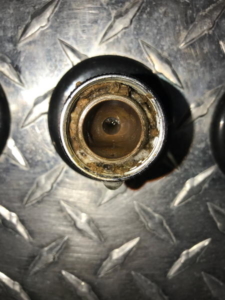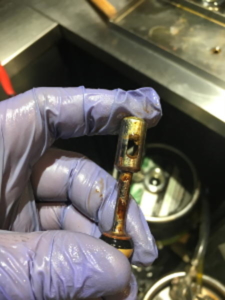by Angelo Orona
5 minute read
If you’ve been around the beer industry for any significant length of time, you’ve probably noticed a lot of changes. Small, nimble craft breweries are snatching up market share both on the shelf and at the draft tower. A business that was once dominated by a few national and regional players has seen an explosion of creative, artisanal breweries.
For the beer drinker, it’s a literal best case scenario. Variety is at its peak and creativity is unparalleled.

Beer keg couplers are often neglected in the field. Establishing a routine of preventative maintenance will inhibit the growth of yeast, mold and bacteria.
Now, imagine this. You’re a brewer at a small, independent brewery. You buy the highest quality ingredients possible. You have robust quality control measures in place. You consistently produce great beer. Once that beer is ready for release, you decide to turn it over to your distribution partner. The beer goes out to your favorite beer bar. Saturday night, you’re excited to go try your new release at your favorite spot. And….there it is. Your beer is a shell of its former self. Lifeless, no foam collar, off flavors. Your beer was ruined in the last 8 feet of its journey.
When the brewer entrusts a company with the stewardship of his beer, he also trusts that the necessary steps will be taken to maintain its quality and integrity.

Beer shanks provide the perfect environment for bacteria to thrive!
Often overlooked, a proper beer line cleaning schedule (bi-weekly) is a vital step that needs to be taken to ensure that the beer is presented as the brewer intended.
As the last line of defense, beer line cleaning technicians play an important role in our industry. Using the appropriate beer line cleaning chemical helps inhibit the growth of yeast, mold and bacteria that can grow in beer lines. The importance of a proper beer line cleaning and maintenance regimen cannot be overstated.
Proper training and dedicated beer line techs can help ensure that the appropriate measures are taken to make that delicate pilsner tastes exactly how it did when it left the brewery.
Luckily, the Brewers Association (an industry trade association tasked with protecting independent brewers) has published the following guidelines:
Cleaning Frequency and Tasks
Every two weeks (14 days)
- Draught lines should be cleaned with a caustic line-cleaning chemical.
- All faucets should be completely disassembled and cleaned.
- All keg couplers or tapping devices should be scrubbed clean.
- All FOB-stop devices (a.k.a. beer savers, foam detectors) should be cleaned in line. Chemicals should be purged through the FOB-stop and vented out of the FOB drain hose.
- Quarterly (every three months)
- Draught beer lines should be de-stoned with an acid line cleaning chemical or a strong chelator that is added to or is part of the alkaline chemical formulation. The Draft Beer Quality working group is working with brewing industry researchers to complete further studies on line-cleaning chemistry, including additives such as Ethylenediaminetetraacetic acid (EDTA).
Semi-annually (every six months)
- All FOB-stop devices (a.k.a. beer savers, foam detectors) should be completely disassembled and hand-detailed (cleaned).
- All couplers should be completely disassembled and detailed.

All faucets should be disassembled and thoroughly scrubbed every cleaning cycle.
Brewer’s Association guidelines can be found at http://www.draughtquality.org

